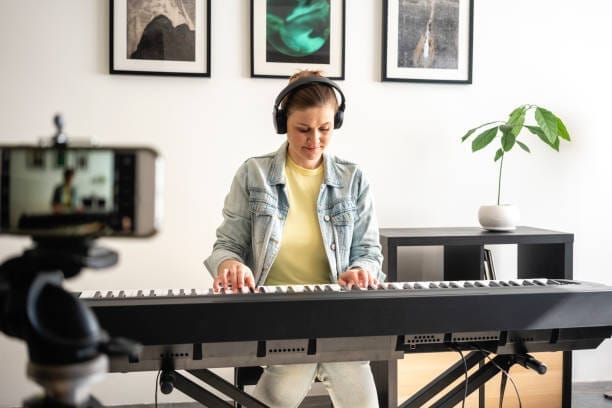How to record yourself to help you practice
1. Set Up the Right Angle
For the most helpful video, make sure your camera captures everything you need to evaluate your playing:
- Use the Back Camera: If you’re using a phone, always use the back camera. The front camera flips the image, which can confuse your left and right sides.
- Film the Whole Keyboard: Position the camera to capture the entire keyboard, so you can see your hand movements across all registers.
- Include Your Hands, Arms, and Posture: The camera should show your hand movements and full arm motion, as well as your posture. This helps you evaluate your technique and ensure you're using a relaxed, efficient playing position.
Capture Your Feet (If Using Pedals): If you’re using the pedal, make sure to include your feet to observe your pedaling technique and check for smooth, controlled use.

2. record yourself with the metronome
on to check if you are truly lining up with the steady beat. Sometimes, when we focus too much on playing the notes or phrasing, we might lose track of the metronome and the tempo. Listening back to your recording with the metronome will help you assess if you're staying in sync with the beat, especially in faster passages or more complex rhythms.
3. Watch the Video and Analyze Your Posture
- Posture Check: Are you sitting up straight with relaxed shoulders? Is your body aligned properly to avoid strain? Are your hands and arms relaxed and positioned well for playing?
- Hand and Arm Movements: Watch how your fingers, wrists, and arms move. Are there any unnecessary tensions or awkward positions that might affect your playing?
4. Listen While Following the Music and Mark it on the Score
Once you’ve watched the video and observed your posture and technique, it’s time to listen critically to your audio recording. Follow along with the score, using a pencil to mark anything that needs improvement. This allows you to evaluate whether you're interpreting the music exactly as written.
- Use a Pencil to Mark: As you listen, mark your score for areas that need attention. This could include:
- Missed notes or rhythms: Are there any places where you stumbled, played the wrong notes, or missed rhythms?
- Dynamics and Articulations: Are you following the dynamics, phrasing, and articulation marks as indicated in the score?
Tempo and Phrasing: Is your phrasing smooth, or does it feel rushed or uneven? Are you maintaining a consistent tempo throughout the piece?
5. Set Goals Based on Your Recording
After reviewing your video and listening to the audio, write down specific goals for your next practice session. For example:
- "Slow down the tempo in measure 16 to get the notes more accurate."
- "Focus on more contrast in the dynamics during the second theme."
- "Relax my shoulders to reduce tension in my wrists."
6. Develop Objectivity
At first, listening to your own playing might feel uncomfortable or even embarrassing. It can be hard to hear mistakes that you didn’t notice while playing. However, this is a crucial step in becoming an objective critic of your own work.
- Be Your Own Teacher: Recording yourself is a fantastic way to develop self-teaching skills, especially if you are learning online.
- Active Listening: By regularly listening critically to your own playing, you train your ears to catch subtle flaws, improve your rhythm, and sharpen your expression.
Mind the Gap: Sometimes, what we think we’re playing and what is actually coming through our hands can differ. Recording yourself helps you identify these discrepancies and make adjustments.

Final Thoughts
Recording yourself during practice isn’t just about catching mistakes—it’s about developing the critical listening and observing skills that will help you grow as a musician. By carefully watching your technique, analyzing your posture, and comparing what you hear to what you see in the music, you can make each practice session more effective. So, grab your camera, record, and start listening critically—this habit will help you become your own best teacher.
Share this article on



